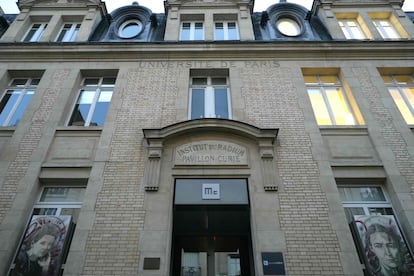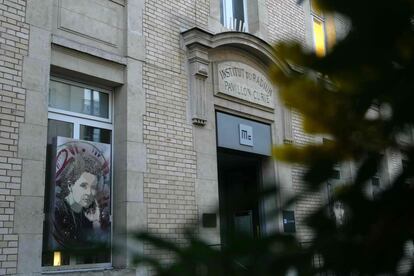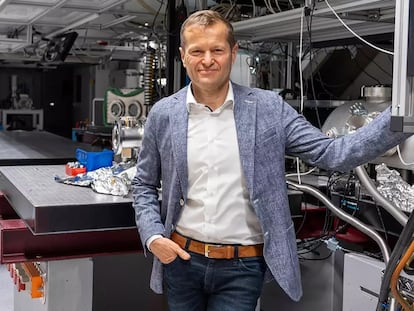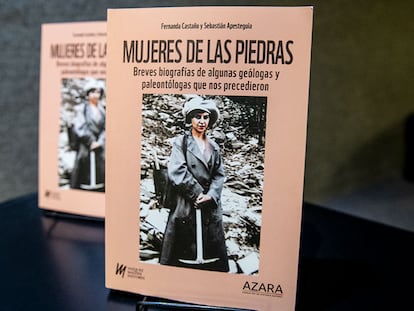Living science or memory? France debates how best to honor Marie Curie’s legacy
The Minister of Culture has temporarily suspended the demolition of the Radium Institute, where the scientist and two-time Nobel laureate did her research

This is the story of a dilemma: how best to preserve the legacy of Marie Curie (1867-1934), a pioneer in radioactivity research and the only woman to win two Nobel Prizes? At its center stands a small, light-colored brick building, whose demolition was suspended temporarily by the French Ministry of Culture. The institute which bears the scientist’s name wants to knock it down in order to build a state-of-the-art cancer center. Conservation defenders want to protect it, and claim that it was an integral part of the laureate’s laboratories. Authorities will have the last word in the matter.
The case is still open. The former Minister of Culture, Rima Abdul-Malak, announced at the beginning of January that she had agreed to suspend the demolition of the Pavillon des Sources, alongside the president of the Curie Institute, Thierry Philip. The decision is temporary, and was made in order to properly examine all the alternatives. Since then, arguments from both sides have followed, one after the other, in articles, forums, and on social media. The government of French President Emmanuel Macron appointed a new minister, Rachi Dati, who was until now the head of the conservative opposition in the Paris City Council.
The building that around which this tension has crystallized, stands two stories tall and measures just over 328 square feet. It is in the Latin Quarter, located on the rive gauche, the left back of the Seine. Next door stand the Sorbonne University and the Pantheon, in which some of France’s greatest figures rest. Among them, Curie and her husband Pierre, winners of the 1903 Nobel Prize in Physics for their work on radioactivity. Eight years later, Marie Curie won another Nobel Prize, this time in chemistry, for her discovery of polonium and radium, two radioactive elements.
The awards, in addition to providing them with visibility, enabled them to improve their working conditions and create the Radium Institute in 1914. Its heir is today’s Curie Institute, a hospital and research center specializing in the fight against cancer. The building in question has been empty since the late 2000s. The barriers that have been erected for its demolition currently prevent anyone from getting too close. Around them stands a small garden, with trees planted by Curie herself. It is flanked by two buildings: the Pavilion Curie, where the scientist had her laboratory, and which today houses a museum, and the Pavilion Pasteur. The complex was designed by the architect Henri-Paul Nénot.
“You can’t separate them, they go together!” Baptiste Gianeselli exclaims over the telephone. The 42-year-old Parisian was the one who raised the alarm over the building’s impending demolition. A fierce defender of this cultural heritage, and the creator of several other petitions, he recalls how the Curies discovered artificial and induced radioactivity on this very site. “Without the Pavillon des Sources, it would not have been possible,” he says.
The space, a kind of annex, was not Curie’s laboratory per se, but it did provide space to store materials and waste. The Curie Museum tells of how the scientist used it to manufacture radium emanation ampoules, at the time destined for military hospitals, which used them to asepticize wounds during the First World War. A few years later, they would be used to treat cancers.
‘‘The whole spirit of Marie Curie is in this project’
The building and the way it was used are at the heart of the current controversy. In February 2023, the Curie Institute obtained demolition permission from the City of Paris. Its aim is to build a five-story, 7,870 square foot laboratory on the same site. A $13 million project, which will serve to develop new chemical compounds for slowing down the development of tumors. Its paralysis is causing concern. And a certain incomprehension.

“The whole spirit of Marie Curie is in this project, even in its governance,” says a group of women scientists and researchers in an article in the newspaper Libération. The research, they point out, will be led by a woman and is part of a plan to strengthen France’s scientific competitiveness in the face of challenges from other countries. Among the signatories, Fatima Mechta-Grigoriu, who is at the head of the project, along with Raphaël Rodriguez.
Continues the column, “We do not deny its heritage, we are preserving it, we assign it value and we cultivate it so that tomorrow, other women can receive the Nobel Prize (…) This is the way in which they will construct new memories for future generations.” The Curie Institute insists on the necessity of being close to existing technological platforms, to the doctors and patients. It also says that the Pavillon des Sources was a radioactive storage site and that it makes up less than 3% of the heritage left by Curie, which it has always strove to preserve.
But their arguments haven’t convinced everyone. “Researchers worked at the site until 2015, and they could go next door without any problem,” Gianeselli says. The points of radioactivity do not represent any danger, say radiation protection authorities, as quoted by Le Monde. Preservation advocates are asking the Ministry of Culture to classify the site as historic, as one of Curie’s two daughters, Ève, has already requested.
They have been joined by feminist groups, such as the Women and Science Association and the Women’s Foundation, which advocate for the preservation of a site emblematic of the female contribution to science. Former diplomat Claudime Monteil, biographer of the Curie family, says that Irène Joliot-Curie, the scientist’s eldest daughter and winner of another Nobel Prize, also worked there. “They are truly women who sacrificed everything without anything in return,” she says by telephone. “They are the only family in the world to have won five Nobel Prizes, who refused to register commercial patents so that anyone could profit from their discovery,” she says.
No one is arguing this legacy. The question is how to honor it. To settle a debate between memory and living science. The director of the Curie Museum, Renaud Huynh, understands both sides. “It’s a tension that naturally exists between science and heritage,” he tells EL PAÍS. His office overlooks the building and the garden. Behind a bench is a small bust of Marie and Pierre. A few steps away, a poster with a photo dated 1923. It is her, on a balcony, looking out over the small green space. In the end, Huynh says, “the decision will be political.”
Sign up for our weekly newsletter to get more English-language news coverage from EL PAÍS USA Edition
Tu suscripción se está usando en otro dispositivo
¿Quieres añadir otro usuario a tu suscripción?
Si continúas leyendo en este dispositivo, no se podrá leer en el otro.
FlechaTu suscripción se está usando en otro dispositivo y solo puedes acceder a EL PAÍS desde un dispositivo a la vez.
Si quieres compartir tu cuenta, cambia tu suscripción a la modalidad Premium, así podrás añadir otro usuario. Cada uno accederá con su propia cuenta de email, lo que os permitirá personalizar vuestra experiencia en EL PAÍS.
¿Tienes una suscripción de empresa? Accede aquí para contratar más cuentas.
En el caso de no saber quién está usando tu cuenta, te recomendamos cambiar tu contraseña aquí.
Si decides continuar compartiendo tu cuenta, este mensaje se mostrará en tu dispositivo y en el de la otra persona que está usando tu cuenta de forma indefinida, afectando a tu experiencia de lectura. Puedes consultar aquí los términos y condiciones de la suscripción digital.
More information
Archived In
Últimas noticias
Most viewed
- Reinhard Genzel, Nobel laureate in physics: ‘One-minute videos will never give you the truth’
- Oona Chaplin: ‘I told James Cameron that I was living in a treehouse and starting a permaculture project with a friend’
- Pablo Escobar’s hippos: A serious environmental problem, 40 years on
- Charles Dubouloz, mountaineering star, retires at 36 with a farewell tour inspired by Walter Bonatti
- Why we lost the habit of sleeping in two segments and how that changed our sense of time











































